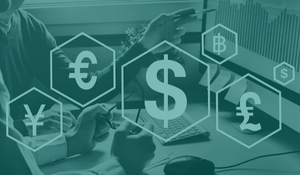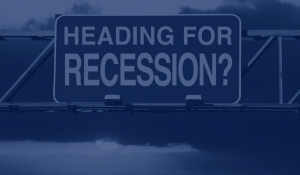U.S. dollars are nearly as valuable as euros today, which is a mixed blessing with major...
The dollar is strong right now. What does that mean for us?
The dollar’s rise has gotten little attention, but it’s worth a discussion.
- The dollar is strong against other currencies right now. There’s a logical explanation why.
- The dollar’s recent strength is a mixed blessing. It involves more than you might think.
- If a stronger dollar doesn’t always mean a stronger economy, what does it mean?
The U.S. dollar is strong right now. Very strong. In fact, it’s approaching its strongest level in 20 years.
The chart below shows the dollar’s strength versus a small group of other currencies:
The strength of a currency refers to its value relative to other currencies. When the black line goes up the dollar is getting stronger, which means it’s become more valuable compared to the others.
So what’s causing this? While the forces that drive currency markets can be tricky, there’s actually a straightforward explanation for today.
Simply put, the world is investing piles of money into U.S. businesses and assets. These investments take place in U.S. currency, so international investors need to get their hands on dollars to make them.
As investors swap their currencies for dollars at increasing rates, the value of the dollar goes up. It’s good old-fashioned supply and demand.
But why would anyone want to invest in the U.S. today?
Historically, investors see dollar-denominated investments as safe-havens during times of global uncertainty. And there’s no shortage of factors contributing to uncertainty today: Russia’s war in Ukraine, lockdowns in China, and slow growth in Europe and Japan, to name a few.
While the U.S. economy has issues of its own, our economy does have real signs of strength today. And the actions of the Fed have led to higher interest rates on many U.S. assets making them more attractive relative to other investments.
International investors demand more dollars to pursue these investments, which increases the strength of our dollar.
A stronger dollar is a mixed blessing. There are both benefits and downsides.
Many people confuse a strong dollar with a strong economy, which is a mistake. Having a strong dollar is actually a bit of a mixed blessing for our economy.
There are some genuine upsides. On top of the investment activity that’s driving the change, the primary benefit is more favorable exchange rates with other nations. This means the dollar “goes farther” when buying foreign goods, so we essentially get a discount on imports. It’s a nice perk.
But a strong dollar has significant downsides too. First, cheaper imports give foreign competitors a leg up against U.S. businesses on their home turf. Also, foreigners are forced to pay higher prices for our exports, which hurts U.S. businesses who rely on selling beyond our borders.
The net effect of this is a growing imbalance in the flow of trade. The stronger dollar promotes a widening trade deficit, which is the difference between the value of what we import versus what we export. The deficit gets bigger when we increasingly import more from the rest of the world than we export to them.
“The stronger dollar promotes a widening trade deficit, which is the difference between the value of what we import versus what we export.”
The blue line in the chart below shows a measure of our trade balance with the rest of the world. The distance between the blue line and the black line is the trade deficit:
The trade deficit is a negative number, so the lower the blue line the larger the difference between our imports and exports. The widening gap today shows how the strong dollar has expanded the trade deficit to record levels.
The growing trade deficit is a drag on our economy, all else equal. It represents U.S. money that’s spent outside our borders rather than within. Remember that this is a result of a stronger dollar.
In contrast, take the period from 2011 to 2019, when a weaker dollar shrank the trade deficit and helped facilitate the economic recovery after the Great Recession.
So a weaker dollar promotes trade that expands our economy, while a stronger dollar works in the opposite direction.
But the impact of a strengthening currency isn’t limited to trade. Remember that the change is driven by foreign demand for U.S. investments in the first place. So although U.S. money is being spent on goods and services beyond our borders, foreign money is flowing into the U.S. in the form of investment funds.
The red line in the chart above shows the inflows of funds from international investors. (Notice that the red and blue lines are are always mirror images of each other, which is a topic for a future post.)
These investments strengthen U.S. businesses and assets and promote economic activity. So while a strong dollar syphons money out of the country in the form of a trade deficit, it’s also pulling money back into the economy in the form of investment funds.
This is a mixed blessing as well. The foreign money flowing into our businesses and financial markets helps bolster economic activity. But that also means future dividends might be flowing to investors outside of our borders. It’s a mixed bag.
So if a stronger dollar doesn’t necessarily mean a stronger economy, what does it mean?
What’s a person to make of all this? First, we all should agree that it’s important for our currency to have some base level of strength. And right now, we can say that the dollar is strong.
But a strengthening dollar is leading more U.S. money to be spent on foreign products. This can be good or bad depending on where you sit.
And the dollar’s gain is leading more foreign money to be invested in U.S. businesses and assets. This could also be good or bad depending on how you see it.
It’s hard to say what the net effect of this will be. What we can say is that right now the dollar is more valuable compared to other currencies than it’s been in almost two decades. Beyond that, it’s complicated.
Don’t be fooled, this is no simple issue. If someone tells you it is, they’re either simple-minded or they think you are.
Stay tuned, more to come.
-1.png?width=50&name=Untitled%20design%20(32)-1.png)




